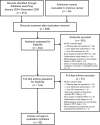Randomized controlled trials of interventions to prevent sexually transmitted infections: learning from the past to plan for the future
- PMID: 20519264
- PMCID: PMC2912604
- DOI: 10.1093/epirev/mxq010
Randomized controlled trials of interventions to prevent sexually transmitted infections: learning from the past to plan for the future
Abstract
Globally, sexually transmitted infections (STIs) represent a significant source of morbidity and disproportionately impact the health of women and children. The number of randomized controlled trials testing interventions to prevent STIs has dramatically increased over time. To assess their impact, the authors conducted a systematic review of interventions to prevent sexual transmission or acquisition of STIs other than human immunodeficiency virus, published in the English-language, peer-reviewed literature through December 2009. Ninety-three papers reporting data from 74 randomized controlled trials evaluating 75 STI prevention interventions were identified. Eight intervention modalities were used: behavioral interventions (36% of interventions), vaginal microbicides (16%), vaccines (16%), treatment (11%), partner services (9%), physical barriers (5%), male circumcision (5%), and multicomponent (1%). Overall, 59% of interventions demonstrated efficacy in preventing infection with at least 1 STI. Treatment interventions and vaccines for viral STIs showed the most consistently positive effects. Male circumcision protected against viral STIs and possibly trichomoniasis. Almost two-thirds of behavioral interventions were effective, but the magnitude of effects ranged broadly. Partner services yielded similarly mixed results. In contrast, vaginal microbicides and physical barrier methods demonstrated few positive effects. Future STI prevention efforts should focus on enhancing adherence within interventions, integrating new technologies, ensuring sustainable behavior change, and conducting implementation research.
Figures

References
-
- Begg C, Cho M, Eastwood S, et al. Improving the quality of reporting of randomized controlled trials. The CONSORT statement. JAMA. 1996;276(8):637–639. - PubMed
-
- US Food and Drug Administration. Food and Drug Administration Modernization Act of 1997. Public Law 105–115, 105th Congress, section 113. DOC ID f:publ115.105. Rockville, MD: Food and Drug Administration; 1997. ( http://www.fda.gov/RegulatoryInformation/Legislation/FederalFoodDrugandC...)
-
- US National Institutes of Health. ClinicalTrials.gov. Bethesda, MD: National Library of Medicine; 2000 ( www.ClinicalTrials.gov). (Accessed November 21, 2009)
-
- Manhart LE, Holmes KK. Randomized controlled trials of individual-level, population-level, and multilevel interventions for preventing sexually transmitted infections: what has worked? J Infect Dis. 2005;191(suppl 1):S7–S24. - PubMed
Publication types
MeSH terms
Grants and funding
LinkOut - more resources
Full Text Sources
Medical
Miscellaneous

